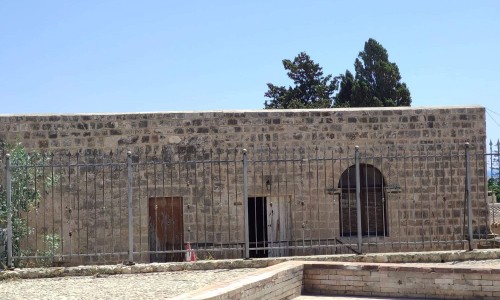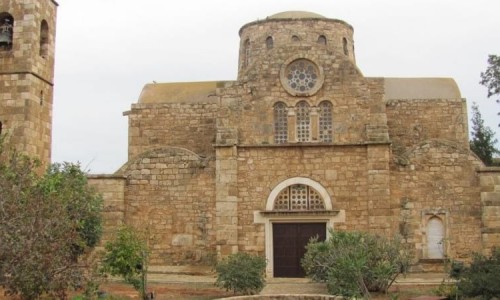St Barnabas Monastery
Just inland from the windswept ruins of ancient Salamis, amid Cyprus’s parched olive groves and sunlit plains, stands the Monastery of St. Barnabas — a monument of deep religious and cultural resonance. Built near the spot where the Apostle Barnabas was laid to rest, this monastery once served as a bastion of Orthodox faith and a spiritual landmark in the island’s long and layered history.
Though no longer an active monastic community, the monastery still speaks — through its walls, icons, and echoing halls — of centuries of devotion, political upheaval, and the unshakable connection between Cyprus and its patron saint.
Founding and Historical Background
The Monastery of St. Barnabas was established in the late 5th century AD, following the miraculous discovery of St. Barnabas’s relics by Archbishop Anthemios. According to tradition, the saint’s body was found near Salamis, holding a copy of the Gospel of Matthew — a divine sign affirming both his apostolic authority and the unique status of the Cypriot Church.
Following this discovery, Emperor Zeno of Byzantium granted the Church of Cyprus the right to self-govern (autocephaly), independent of other patriarchates. To mark this turning point, a monastery was founded close to the tomb — both as a shrine and as a symbol of the island’s ecclesiastical autonomy.
The monastery’s original buildings were modest, but over the centuries, it evolved, especially under Ottoman and later British rule, into a more elaborate complex that remained a functioning religious center until the 1970s.
Architecture and Layout
Today’s monastery complex reflects a blend of Byzantine and later influences, with most of the visible structures dating to the 18th century, the result of significant restoration and rebuilding.
Key features include:
1. The Church
The central church is a three-domed basilica with a plain yet powerful presence. Its whitewashed exterior and simple façade conceal a richly decorated interior. Though no longer active for worship, the church is now a museum of icons, featuring:
- Wooden iconostasis from the 18th century
- Icons of Christ, the Virgin Mary, and local saints
- Painted panels and ecclesiastical artifacts
The space is quiet, dimly lit, and charged with a sense of reverence that still lingers despite its secular function.
2. The Courtyard
Surrounded by arched cloisters, the courtyard is an open, almost monastic square. Palm trees and fragments of ancient stonework line the edges, while the low-slung monks' cells now house archaeological exhibits.
The courtyard also serves as the main gathering point for visitors and the entrance to both the church and the museum sections.
3. The Archaeological Museum
Located in the former living quarters of the monks, this small but diverse museum houses finds from nearby tombs and settlements, including:
- Pottery from the Bronze Age
- Glassware and jewelry
- Roman and Hellenistic figurines
- Local tools and ornaments
This museum adds a layer of historical depth to the religious focus of the site, tying the monastery to the broader cultural story of Cyprus.
The Tomb of St. Barnabas
About 300 meters west of the monastery, a small chapel marks the traditional burial site of St. Barnabas. This low, cave-like crypt holds a stone sarcophagus believed to be the saint’s final resting place. The tomb, modest and shadowy, remains a place of pilgrimage.
Despite its humble appearance, this chapel is arguably more spiritually potent than the main monastery — it’s the place where history, legend, and devotion converge.
Decline and Preservation
After the Turkish intervention in 1974 and the division of the island, the monastery ceased functioning as a religious institution. The Greek Orthodox clergy and monastic community were forced to abandon it. Since then, the monastery has remained under the control of the Turkish-Cypriot administration and has been converted into a museum complex.
While the site has been preserved in reasonably good condition, it no longer serves as a living religious community. Nonetheless, pilgrims and tourists still visit—both to honor the saint and to experience one of the few surviving examples of Orthodox monastic life in the region.
Visiting the Monastery Today
- Location: Near the village of Tuzla (ancient Enkomi), west of Famagusta
- Status: Museum (no active religious function)
- Main Attractions:
- Icon museum inside the church
- Archaeological museum in the cloisters
- Tomb of St. Barnabas nearby
- Atmosphere: Quiet, respectful, and contemplative — with a subtle blend of abandonment and endurance
Visitors are encouraged to dress modestly and to approach the site with reverence, even though it no longer functions as a place of worship.
The Monastery of St. Barnabas stands as a sacred relic of Cyprus’s spiritual history — a place where the memory of a saint became a foundation for religious independence and cultural identity. Though no monks chant in its courtyards today, and no incense burns in its sanctuary, the monastery still holds the silence of prayer and the weight of centuries.
For those who visit, it is not only a museum of faith but a living testament to Cyprus’s enduring soul.






